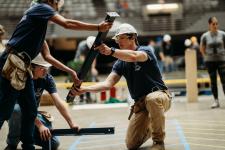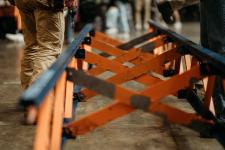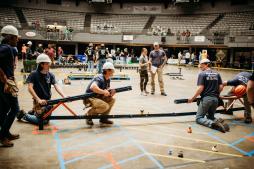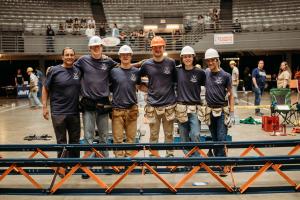
A machine called a hydraulic actuator whirred as its cylinder pivoted into position and pressed down with 2,500 pounds of weight. It was the moment that would either make or break their project.
The six University of Virginia engineering students had challenged themselves to build a 20-foot-long steel bridge in record time — less than a year — despite none of them having designed or created anything like it before.
If the bridge absorbed the load, the fourth-year students would have not only succeeded in their Department of Civil and Environmental Engineering capstone work, which represents the culmination of their undergraduate training at the School of Engineering and Applied Science, but they would also be on their way to competing in the American Society of Civil Engineers’ steel bridge competition.
So, did the bridge hold or fold under the weight test?
The students stood back a safe distance as the actuator made contact with a pair of thick wooden boards between the machine and the bridge. That was in case the wood shattered. Instead, the bridge flexed as designed. José Pantaleon Gomez III, the lecturer who teaches the capstone course, took a measuring stick and verified an inch of deflection, meaning the amount of give, under the 2,500 pounds of weight.
Ryan Henry, the Civil and Environmental Engineering lab manager who advises the ASCE student competitors, put the actuator in oscillation mode, where the bridge’s ability to flex became even more dramatic. The motion was reminiscent of a heart muscle at work.
“You’ve got to feel good about that,” said Gomez, a Double Hoo who earned his M.E. and Ph.D. in civil engineering at UVA. For the former research director at the Virginia Transportation Research Council, teaching students to build steel bridges combines innovation, collaboration and safety awareness — all of which the future builders and stewards of our infrastructure will need.
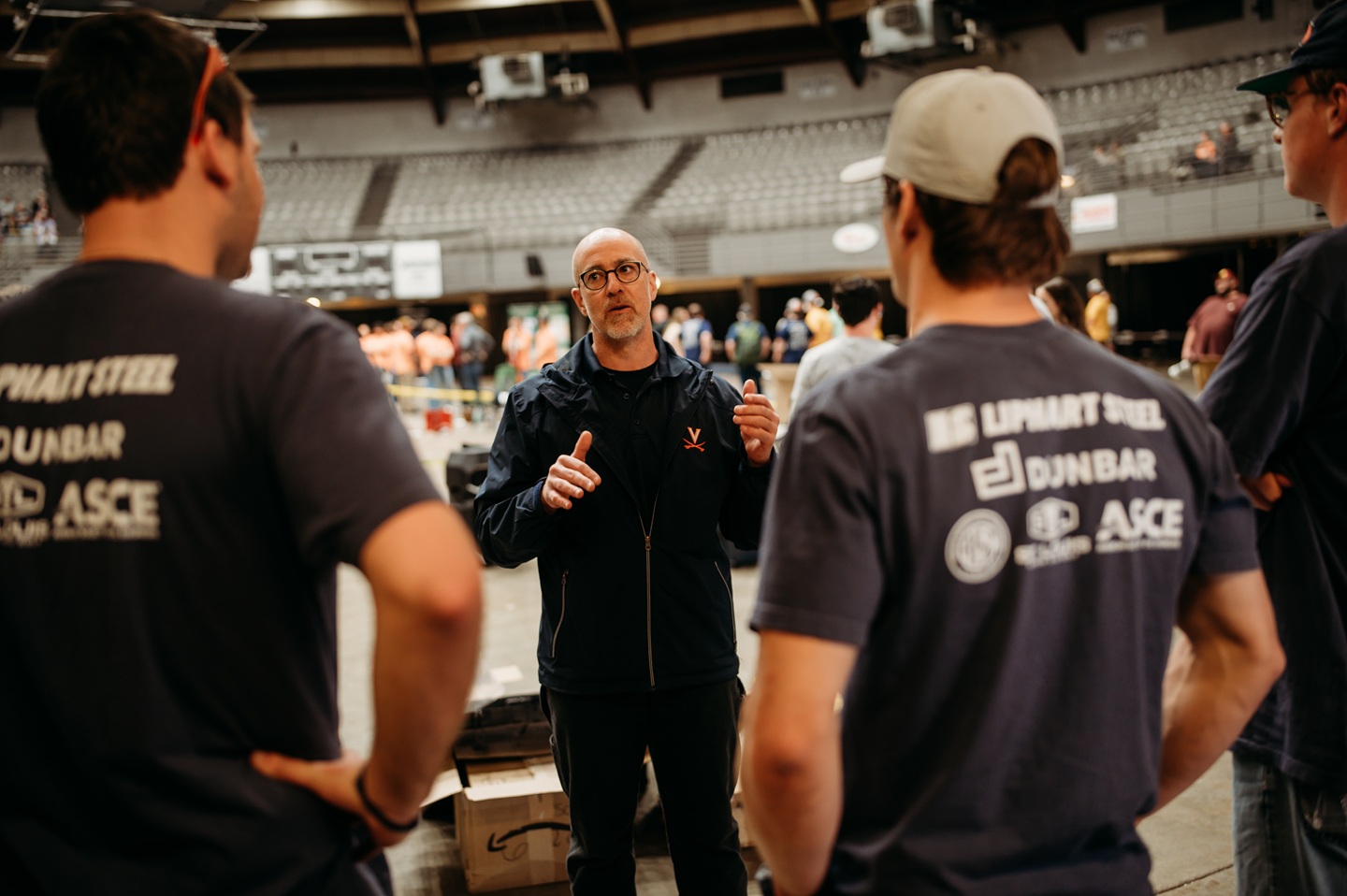
Design, Build, Learn
Normally, students who participate in the ASCE competition have a strong history of learning first as underclass members of an extracurricular steel bridge building club. But UVA’s team had to rebuild its involvement in the competition following COVID. Though the club had reformed by last year, these fourth-years were starting fresh. To solve the problem, UVA Engineering provided them the opportunity to pursue the experiential learning project as their capstone.
“This is a six-student team that’s never been on the field before, with probably limited experience with tools,” Henry said. “They started the fire early, and it's burned all year. They recruited some younger club members along the way, too.
This year’s ASCE test of skill was to build a bridge with one end having a side that was longer than its parallel side — as if the bridge were attached to, and skewed alongside, a natural water boundary. The students used the fall semester to figure out exactly how they wanted to build it.
Throughout the semester we would meet as a team and brainstorm design ideas together.

“Throughout the semester we would meet as a team and brainstorm design ideas together,” said Zoe DeGuzman, the design and modeling captain. “Then afterwards I would update those changes in the model accordingly and give everyone feedback based on the analysis.”
In addition to collaborating as builders, students Bear Matheson and Cooper Davenport served as the donation and funding captains, respectively, helping to secure the resources needed.
The lion's share of the funding came from the UVA Engineering Experiential Learning Fund, led by Tomonari Furukawa, professor and Zinn Faculty Scholar.
Even so, the ELF doesn’t cover all expenses, “which made us have to work even harder to shave costs and find new funds,” Davenport said.
Matheson oversaw putting together the application and communicating with the ELF. Davenport was responsible for donations from companies and local stores. Liphart Steel Co., the steel supplier and fabricator, was the main donor. “They gave us the best price they could and supported the team constantly throughout,” Henry said. Alumnus John Ward (B.S.C.E. 2012), a structural engineer with Dunbar Structural, donated resources and consulting. The other donors were St. Louis Screw & Bolt Co., Martin's Hardware and competition sponsor the American Society of Civil Engineers, in association with the American Institute of Steel Construction.
“My part was making sure we received the steel procurement and then making sure we stuck to a schedule of what needed to get done,” construction and team captain Wren Sadler said.
Welding and Other New Skills
Learning to weld and to use other high-caliber professional tools was a big reason Sadler and other team members said they wanted to make the bridge their capstone course. Sebring Smith, UVA’s shop manager at Lacy Hall, found workspace for them at the building and trained the students to use the tools safely.
“If there's no construction, there's no bridge,” utility captain Eric Venner said. “I think I had the most fun when we had the tangible steel and started getting in the shop. Modeling and planning are super-important, but at the same time, you do have to figure out a lot on the fly — like know exactly where the bolts are going to be facing and how the angles exactly are going to line up and everything.”
The initial finishing work was not without a few scares.
“We did a test section at the start,” Venner said. “Me and Ben [Van Zandt, co-captain and club captain] were worried because we did some calculations and thought we messed up. We thought the section was slightly shorter than it was supposed to be. But it ended up not being an issue whatsoever.”
From the experience, he said, they were reminded that a time-honored adage holds true: “measure twice, cut once.”
The students all reported having their next steps lined up after graduation, with Van Zandt pursuing a graduate degree and the others working with construction-oriented employers.
